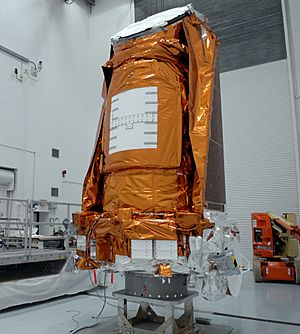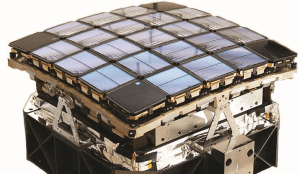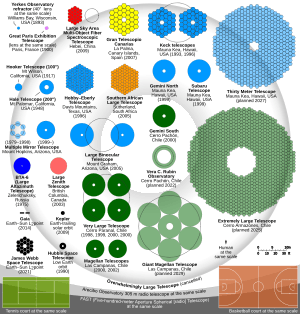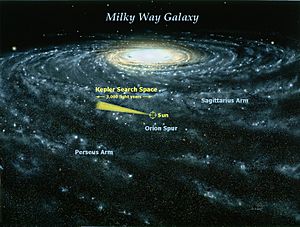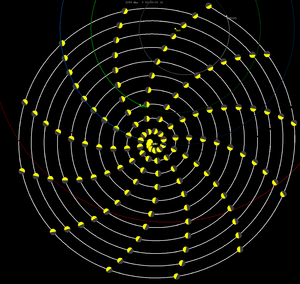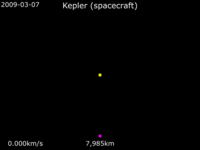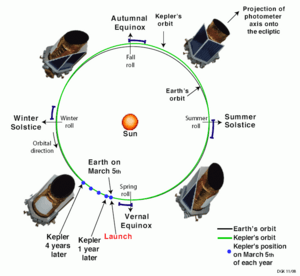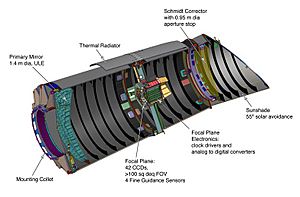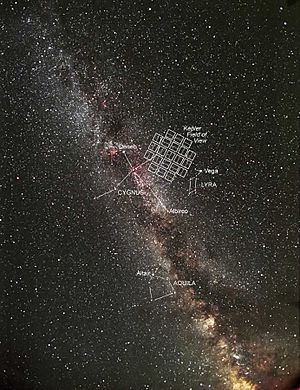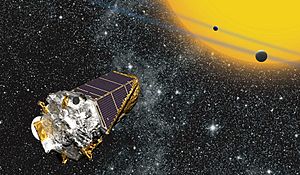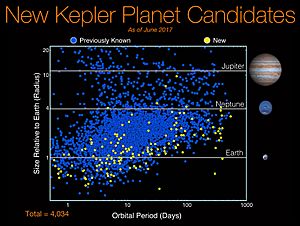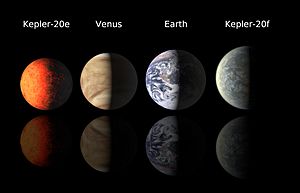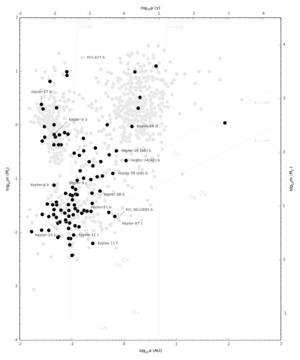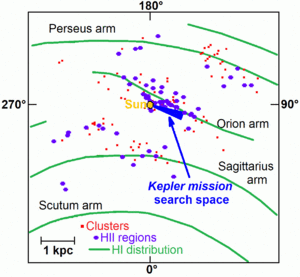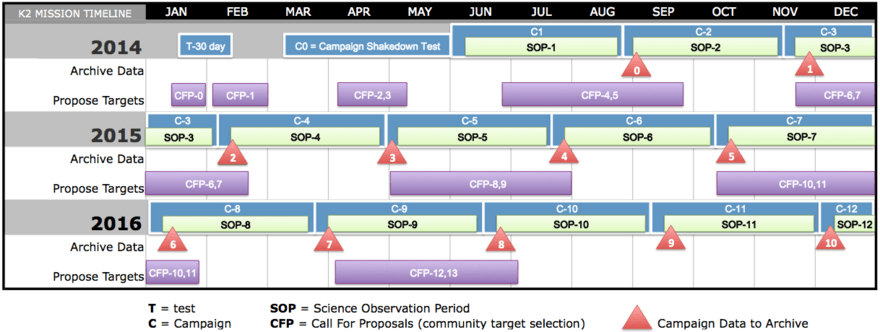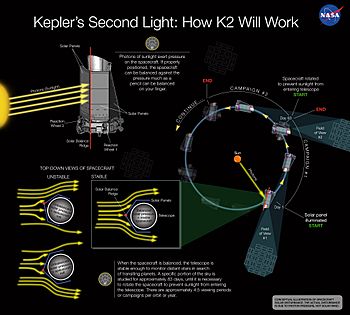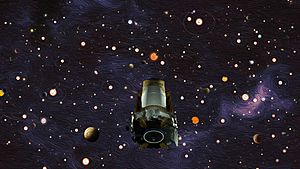Kepler space telescope facts for kids
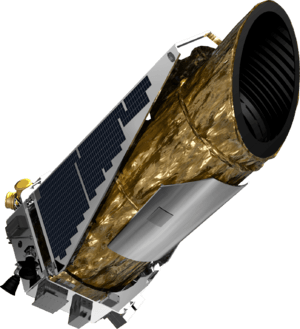
Artist's impression of the Kepler telescope
|
|
| Mission type | Space telescope |
|---|---|
| Operator | NASA / LASP |
| Mission duration | Planned: 3.5 years Final: 9 years, 7 months, 23 days |
| Spacecraft properties | |
| Manufacturer | Ball Aerospace & Technologies |
| Launch mass | 1,052.4 kg (2,320 lb) |
| Dry mass | 1,040.7 kg (2,294 lb) |
| Payload mass | 478 kg (1,054 lb) |
| Dimensions | 4.7 m × 2.7 m (15.4 ft × 8.9 ft) |
| Power | 1100 watts |
| Start of mission | |
| Launch date | March 7, 2009, 03:49:57 UTC |
| Rocket | Delta II (7925-10L) |
| Launch site | Cape Canaveral SLC-17B |
| Contractor | United Launch Alliance |
| Entered service | May 12, 2009, 09:01 UTC |
| End of mission | |
| Deactivated | November 15, 2018 |
| Orbital parameters | |
| Reference system | Heliocentric |
| Regime | Earth-trailing |
| Semi-major axis | 1.0133 AU |
| Eccentricity | 0.036116 |
| Perihelion | 0.97671 AU |
| Aphelion | 1.0499 AU |
| Inclination | 0.4474 degrees |
| Period | 372.57 days |
| Argument of perihelion | 294.04 degrees |
| Mean anomaly | 311.67 degrees |
| Mean motion | 0.96626 deg/day |
| Epoch | January 1, 2018 (J2000: 2458119.5) |
| Main telescope | |
| Type | Schmidt |
| Diameter | 0.95 m (3.1 ft) |
| Collecting area | 0.708 m2 (7.62 sq ft) |
| Wavelengths | 430–890 nm |

|
|
The Kepler space telescope was a special space telescope launched by NASA. Its main job was to find planets similar to Earth that orbit other stars, known as exoplanets. It was named after the famous astronomer Johannes Kepler. The telescope launched on March 7, 2009. It orbited the Sun, slowly trailing behind Earth.
Kepler's mission lasted for nine and a half years. It ran out of fuel and NASA announced its retirement on October 30, 2018. Kepler was designed to look at a part of our Milky Way galaxy. It searched for Earth-size exoplanets that might be in a "habitable zone". This is an area around a star where conditions could be right for liquid water to exist. Scientists wanted to know how many stars in the Milky Way might have such planets.
Kepler's only science tool was a special camera called a photometer. This camera constantly watched the brightness of about 150,000 stars. These stars were all in a fixed area of space. The data was sent back to Earth. Scientists then looked for tiny, regular dips in a star's brightness. These dips happen when an exoplanet passes in front of its star, blocking some of its light. This method is called the transit method. Kepler could only find planets whose orbits were seen edge-on from Earth. During its mission, Kepler observed over 530,000 stars and found 2,662 confirmed planets.
Kepler's Journey in Space
The Kepler space telescope was part of NASA's Discovery Program. This program focuses on science missions that cost less money. NASA's Jet Propulsion Laboratory managed the telescope's building and early operations. Ball Aerospace & Technologies built the Kepler flight system. The Ames Research Center handled the ground systems, mission operations, and data analysis.
Kepler was supposed to work for 3.5 years. But there was more "noise" in the data than expected. This noise came from both the stars and the spacecraft itself. So, more time was needed to finish all the mission's goals. In 2012, NASA planned to extend the mission until 2016.
Challenges and Solutions
On July 14, 2012, one of Kepler's four reaction wheels stopped working. These wheels help the spacecraft point accurately. Kepler needed at least three wheels to aim correctly. Another wheel failed on May 11, 2013. This meant Kepler could no longer collect science data as planned.
On August 15, 2013, NASA announced they couldn't fix the two broken wheels. This changed the mission, but it didn't stop the search for planets. NASA asked scientists to suggest new ways to use Kepler. These new plans would use the two working wheels and small thrusters.
A new idea, called the "K2" or "Second Light" mission, was proposed. This plan would use the damaged Kepler to find planets around smaller, dimmer stars called red dwarfs. NASA approved the K2 extension on May 16, 2014.
Amazing Discoveries
By January 2015, Kepler had found 1,013 confirmed exoplanets. These planets were in about 440 star systems. It also found 3,199 more possible planet candidates. The K2 mission confirmed four planets.
In November 2013, scientists used Kepler's data to estimate something amazing. They thought there could be as many as 40 billion rocky Earth-size exoplanets. These planets would be orbiting in the habitable zones of Sun-like stars and red dwarfs in our Milky Way galaxy. About 11 billion of these might orbit Sun-like stars. The closest such planet could be about 12 light-years away.
On January 6, 2015, NASA announced Kepler's 1,000th confirmed exoplanet. Four of the new planets were in habitable zones. Three of them, Kepler-438b, Kepler-442b, and Kepler-452b, are almost Earth-size and likely rocky. The fourth, Kepler-440b, is a super-Earth. On May 10, 2016, NASA confirmed 1,284 new exoplanets from Kepler data. This was the largest single finding of planets ever.
Kepler's data also helped scientists study supernovae. These are huge star explosions. Kepler collected measurements every half-hour. This made its light curves very useful for studying these events.
On October 30, 2018, Kepler ran out of fuel. NASA announced the telescope's retirement. It was shut down that same day, ending its nine-year mission. Kepler observed 530,506 stars and found 2,662 exoplanets. A newer NASA mission, TESS, launched in 2018, continues the search for exoplanets.
How Kepler Was Built
The Kepler telescope weighed about 1,039 kilograms (2,291 pounds). It had a special camera called a Schmidt camera. This camera used a 0.95-meter (37-inch) front lens. It fed light to a 1.4-meter (55-inch) primary mirror. When it launched, this was the largest mirror on any telescope outside Earth's orbit.
Kepler's telescope had a wide field of view (FoV) of 115 square degrees. This is about the size of your fist held at arm's length. The camera was designed to have a "soft focus." This helped it measure brightness changes very precisely, rather than taking super sharp pictures.
Kepler's Camera System
The camera's focal plane had 42 special sensors called CCDs. Each CCD was 50 by 25 millimeters (2 by 1 inches). Together, they had a total resolution of 94.6 megapixels. At the time, this was the largest camera system ever launched into space.
The CCDs took readings every 6.5 seconds. This prevented them from getting too much light. The data was then combined on board. For short observations, data was combined for about a minute. For longer observations, it was combined for about 29 minutes.
Kepler couldn't store and send all the data from its 95 million pixels. So, the science team chose only the pixels related to the stars they were studying. This was about 6 percent of the pixels (5.4 megapixels). This data was then compressed and stored on a 16-gigabyte solid-state recorder.
The Main Mirror
The Kepler primary mirror is 1.4 meters (4.6 feet) across. It was made by Corning using special "ultra-low expansion" glass. This glass helps the mirror stay stable in space. The mirror was designed to be very light, only 14% the mass of a solid mirror of the same size.
To find small planets, the mirror needed to reflect light very well. A company called Surface Optics Corp. put a special nine-layer silver coating on the mirror. This coating made it reflect light better and protected it.
How Well Kepler Saw Things
Kepler's camera worked very well, much better than any telescope on Earth. But it didn't quite meet its original goals for precision. It aimed for a precision of 20 parts per million (PPM) for a magnitude 12 star. This means it could detect a change in brightness of 20 parts out of a million.
The actual precision was around 29 PPM. Most of this extra "noise" came from the stars themselves, which varied more than expected. The rest was from small instrument noises. An Earth-size planet passing in front of a Sun-like star causes a tiny brightness drop, only about 80 PPM. Because of the increased noise, each transit was harder to spot. This meant scientists needed to see more transits to be sure they had found a planet.
Scientists thought the mission would need to last 7 to 8 years to find all Earth-sized planets. The mission was approved to continue through 2016. However, this depended on the reaction wheels staying healthy, which didn't happen.
Kepler's Orbit and Direction
Kepler orbits the Sun. This helps it avoid Earth blocking its view or creating stray light. It also avoids the pull of Earth's gravity. NASA calls Kepler's path an "Earth-trailing" orbit.
Kepler takes 372.5 days to orbit the Sun. This means it slowly falls farther behind Earth, about 16 million miles (26 million kilometers) each year. By May 2018, Kepler was about 0.917 AU (137 million kilometers) from Earth. It would take about 26 years for Kepler to reach the other side of the Sun. It would return near Earth after 51 years.
Until 2013, Kepler's camera pointed at a specific area of the sky. This area was in the northern constellations of Cygnus, Lyra, and Draco. This direction was far from the ecliptic plane (the path the Sun seems to take across the sky). This ensured sunlight never entered the camera.
Kepler stayed stable by using special sensors on its camera. It also used reaction wheels and small thrusters to control its direction.
Running the Mission
Kepler was operated from Boulder, Colorado. The Laboratory for Atmospheric and Space Physics (LASP) managed it. Kepler's solar panels were turned to face the Sun during the solstices and equinoxes. This made sure the panels got enough sunlight. It also kept the heat radiator pointing into deep space.
LASP and Ball Aerospace controlled the spacecraft from the University of Colorado. LASP planned the mission and collected the science data. The mission's initial cost was about $600 million. This included 3.5 years of operation. In 2012, NASA said Kepler would be funded until 2016, costing about $20 million per year.
Talking to Kepler
NASA contacted Kepler twice a week using an X band radio link. This was for sending commands and getting status updates. The science data was downloaded once a month. This used a Ka band link, which could send data at up to 4.3 megabits per second.
Kepler's main antenna couldn't move. So, to send data, the whole spacecraft had to turn to point the antenna at Earth. This meant data collection was paused for about a day each month. Kepler also did some analysis on board. It only sent back the most important science data to save bandwidth.
Managing the Data
The science data collected by Kepler was sent to the Kepler Data Management Center (DMC). This center is at the Space Telescope Science Institute in Baltimore, Maryland. The DMC processed the raw data into a usable format. Then, it sent the data to the Science Operations Center (SOC) at NASA Ames Research Center.
The SOC calibrated the data and did the final processing. They also developed software to process the data. During the mission, the SOC:
- Received raw data from the DMC.
- Applied analysis to create calibrated data for each star.
- Searched for planet transits (called threshold-crossing events).
- Checked if planet candidates were real or false alarms.
The SOC also checked how well the camera was working. Finally, the SOC sent the processed data back to the DMC. This data was then stored and shared with astronomers worldwide.
Problems with Reaction Wheels
On July 14, 2012, one of Kepler's four reaction wheels failed. These wheels are vital for pointing the telescope precisely. Kepler needs three working wheels to aim accurately.
On May 11, 2013, a second reaction wheel failed. This put Kepler's main mission at risk. Kepler stopped collecting science data in May because it couldn't point well enough. Engineers tried to fix the wheels in July and August. They found that both failed wheels had too much friction to be useful.
On August 15, 2013, NASA announced that Kepler would no longer search for planets using the transit method. This was because the wheels couldn't be fixed. Sending astronauts to repair Kepler was not possible. It orbits the Sun, millions of kilometers from Earth.
Even with the problems, scientists still had a lot of data to look at. They expected to make more discoveries in the next few years.
Kepler's Timeline
In January 2006, Kepler's launch was delayed by eight months due to budget cuts. It was delayed again in March 2006. To save money, the main antenna was changed. It was fixed to the spacecraft instead of being able to move. This meant one day of observation per month would be lost for communications.
The Kepler observatory launched on March 7, 2009, from Cape Canaveral Air Force Station, Florida. The launch was successful. The telescope's cover was removed on April 7, 2009. The first images, called "first light" images, were taken the next day.
On April 20, 2009, scientists decided to adjust the focus. This would greatly improve the science results. On April 23, 2009, the focus was successfully adjusted. The main mirror was moved slightly.
On May 13, 2009, Kepler finished its setup phase. It officially began its search for planets around other stars.
On June 19, 2009, Kepler sent its first science data to Earth. It had entered "safe mode" on June 15. This happened again on July 2. Both times, it was caused by a computer reset. The spacecraft returned to normal operation on July 3. The collected data was sent down that day. Scientists later found the problem was with a low voltage power supply.
In January 2010, one part of the camera's focal plane sent strange data. This suggested a problem with two of Kepler's 42 CCDs. By October 2010, this part was "failed." But Kepler still had enough working parts to meet its science goals.
Kepler sent about twelve gigabytes of data once a month. For example, a large data download happened on November 22–23, 2010.
Kepler's View of the Sky

Kepler had a fixed field of view (FOV) in the sky. This diagram shows where the camera's fields were located. It also shows some bright stars. The mission website has a tool to check if a specific object is in Kepler's view.
Kepler's field of view covered 115 square degrees. This is about 0.25 percent of the whole sky. It's like looking at "about two scoops of the Big Dipper." You would need about 400 Kepler-like telescopes to cover the entire sky. Kepler's field included parts of the constellations Cygnus, Lyra, and Draco.
The closest star system in Kepler's view is Gliese 1245. It's a triple star system, 15 light-years from the Sun.
What Kepler Wanted to Find
Kepler's main science goal was to understand the different types of planetary systems. It watched many stars to achieve several key objectives:
- To find out how many Earth-size and larger planets exist in or near the "habitable zone" of different types of stars. These are often called "Goldilocks planets" because they are "just right" for life.
- To figure out the range of sizes and shapes of these planets' orbits.
- To estimate how many planets are in systems with multiple stars.
- To learn about the size, brightness, mass, and density of large planets that orbit very close to their stars.
- To find other planets in systems where one planet was already discovered.
- To learn about the stars that have planetary systems.
Most exoplanets found before Kepler were giant planets, like Jupiter or bigger. Kepler was designed to find much smaller planets, closer to Earth's mass. Jupiter is 318 times more massive than Earth.
Kepler used the transit method. This means it watched for planets passing in front of their stars. When a planet transits, it causes a tiny dip in the star's brightness. For an Earth-size planet, this dip is about 0.01%. The size of the dip tells scientists the planet's diameter. The time between transits tells them the planet's orbital period. From this, they can estimate the planet's distance from its star and its temperature.
The chance of a planet's orbit being perfectly lined up with Earth is small. For an Earth-size planet orbiting a Sun-like star, it's about 1 in 210. But if a star has many planets, the chance of seeing more transits increases. This is because planets in a system often orbit in similar planes.
Kepler's wide field of view gave it a much better chance of finding Earth-sized planets than the Hubble Space Telescope. Hubble's view is much smaller. Also, Kepler was dedicated to finding transiting planets. Hubble is used for many different science questions.
Out of about half a million stars in its view, Kepler chose to observe about 150,000. Most of these were similar to our Sun. Kepler was designed to see light in wavelengths from 400 to 865 nanometers. This is where these stars shine brightest. Most stars Kepler watched were faint, but some were brighter. All the chosen stars were watched at the same time. Kepler measured their brightness changes every thirty minutes. This increased the chance of seeing a transit.
Kepler needed to see at least three transits to confirm a planet. Larger planets give a stronger signal, so they were easier to find first. The first discoveries were large planets orbiting close to their stars. Smaller planets and those farther from their stars took longer to find. Earth-sized planets were expected to take three years or more to discover.
Kepler's data was also used to study variable stars. These are stars whose brightness changes on their own. It also helped with asteroseismology. This is the study of how stars vibrate, similar to how we study earthquakes on Earth.
How Planets Are Found
Finding Possible Planets
After Kepler collected and sent data, scientists created "light curves." These graphs show how a star's brightness changed over time. They adjusted the brightness values to account for the spacecraft's own movements. Then, special software looked for signals that looked like a planet transit. Any such signal was called a "threshold crossing event."
These signals were then checked by humans. The first check was very quick. It removed false alarms, signals from instrument noise, and obvious eclipsing binaries (two stars orbiting each other, where one blocks the light of the other).
Signals that passed these checks were called Kepler Objects of Interest (KOI). They were given a KOI number and saved. KOIs were checked even more carefully. Those that passed became "Kepler planet candidates." The KOI list can change. A candidate might later be found to be a false alarm. Or a false alarm might later be confirmed as a planet.
Not all planet candidates went through this exact process. Planets orbiting two stars (called circumbinary planets) don't transit regularly. They needed different ways of checking. Also, other scientists used their own methods to find planets from Kepler's raw data. These planets might not have a KOI number.
Confirming Planet Candidates
Once possible planets were found, scientists needed to make sure they weren't false alarms. They used other telescopes on Earth to take images of the stars. This helped them see if any background objects were affecting the brightness signal. Another way to rule out false alarms was using astrometry. This method measures tiny shifts in a star's position. Kepler could collect this data, even though it wasn't its main goal. While Kepler couldn't find planets this way, it could tell if a transit was caused by another star, not a planet.
Using Other Detection Methods
Several other methods helped confirm if a candidate was a real planet. One method is called doppler spectroscopy. This needs follow-up observations from telescopes on Earth. It works best for massive planets or planets around bright stars. This method can also find other massive planets that don't transit.
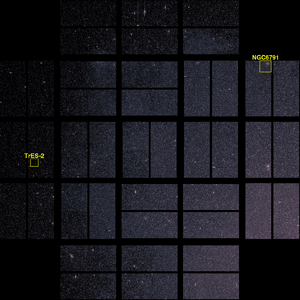
In systems with multiple planets, planets can often be confirmed using transit timing variation (TTV). This means looking at the time between transits. If planets are pulling on each other with gravity, these times can change. This helps confirm smaller planets, even around distant stars. TTVs show that two or more planets belong to the same system. Sometimes, a planet that doesn't transit can even be found this way.
Circumbinary planets show much larger TTVs than planets in single-star systems. Their transit times also vary a lot. These variations are caused by the host stars orbiting each other. It's harder to find circumbinary planets because their transits aren't regular. But it's easier to confirm them. Their unique timing patterns can't be faked by other types of objects.
Besides transits, planets also reflect light from their stars. Like our Moon, they go through phases from full to new. Kepler couldn't see the planet separately from the star. So, it saw the combined light. The star's brightness seemed to change in a regular way as the planet orbited. This effect is tiny. But sensitive telescopes like Kepler could detect it for large planets orbiting very close to their stars. This method might help find more planets than the transit method. This is because it doesn't require the planet to pass directly in front of the star.
Kepler's precision was often good enough to see a star's brightness change due to doppler beaming. This is a small change in brightness caused by the star's motion. It could also see changes from a star's shape being pulled by a companion. These effects sometimes helped rule out false alarms.
Confirming by Validation
If a planet couldn't be confirmed by other methods, it could be "validated." This means showing that the chance of it being a real planet is much higher than any false alarm. One early method was to see if other telescopes could also detect the transit. Kepler-22b was one of the first planets confirmed this way. This type of confirmation is expensive, especially for small planets.
In 2014, a new method called "validation by multiplicity" was announced. Scientists found that planets in most multi-planet systems orbit in a relatively flat plane. This is similar to our own Solar System. So, if a star has many planet candidates, it's very likely a real planetary system. The transit signals still needed to meet certain rules. For example, they needed a strong signal and at least three observed transits. The planet's orbit also had to be stable. This method was very efficient. It allowed hundreds of Kepler candidates to be confirmed quickly.
A new validation tool called PASTIS was developed. It can confirm a planet even if only one transit event was seen. However, it needs a very strong signal from Kepler's data. So, it mainly confirms larger planets or planets around quiet, bright stars. PASTIS was first used to validate the planet Kepler-420b.
Kepler's Discoveries


The Kepler space telescope operated from 2009 to 2013. Its first major results were announced on January 4, 2010. As expected, the first planets found had short orbital periods. As the mission continued, more planets with longer periods were discovered. By October 2017, Kepler had found 5,011 exoplanet candidates and 2,512 confirmed exoplanets.
Early Discoveries (2009-2010)
On August 6, 2009, NASA announced that Kepler had confirmed the known exoplanet HAT-P-7b. This showed Kepler was working well enough to find Earth-size planets. Stars that change brightness on their own (variable stars) are not good for finding transiting planets. Kepler scientists found about 7,500 such stars and removed them from the target list.
The first six weeks of data revealed five new planets. All of them orbited very close to their stars. Notable findings included one of the least dense planets ever found. Also, Kepler-16b was discovered, a planet orbiting two stars.
On June 15, 2010, Kepler released data on most of its target stars to the public. This data showed 706 possible exoplanet candidates. Their sizes ranged from Earth-size to larger than Jupiter. The data included five possible multi-planet systems.
The 2010 results suggested that most candidate planets were smaller than Neptune. They also showed that small planets with short orbits were much more common than large ones. This went against older ideas. Based on Kepler's data, scientists estimated there could be around 100 million habitable planets in the Milky Way.
In 2010, Kepler also found two systems with objects smaller and hotter than their parent stars. These were likely low-mass white dwarfs.
More Planets Found (2011-2013)
On February 2, 2011, the Kepler team announced 1,235 planet candidates around 997 stars. About 68 were Earth-size, and 288 were super-Earth-size. Most of the planets (74%) were smaller than Neptune. This was different from earlier findings, which mostly found large planets.
The 2011 release included 54 candidates that might be in the "habitable zone". Five of these were less than twice the size of Earth. Before this, only two planets were thought to be in the habitable zone. This greatly increased the number of possible "Goldilocks planets." All these candidates orbited stars smaller and cooler than the Sun.
By December 5, 2011, Kepler had found 2,326 planet candidates. The number of Earth-size and super-Earth-size planets had greatly increased. 48 planet candidates were found in habitable zones.
On December 20, 2011, Kepler announced the first Earth-size exoplanets, Kepler-20e and Kepler-20f. They orbited a Sun-like star, Kepler-20.
Based on Kepler's findings, scientists estimated in 2011 that there are "at least 50 billion planets in the Milky Way." Of these, "at least 500 million" are in the habitable zone. Other estimates suggested "two billion" Earth-like planets in the Milky Way alone.
In January 2012, astronomers reported that each star in the Milky Way might host "at least 1.6 planets" on average. This means over 160 billion planets could exist in our galaxy. Kepler also saw distant stellar super-flares. Some were 10,000 times more powerful than any seen from our Sun. These superflares might be caused by large planets orbiting close to their stars.
In January 2013, scientists announced 461 more planet candidates. The longer Kepler watched, the more planets with long orbital periods it could find. NASA stated that the number of candidates had grown to 2,740.
A new candidate announced on January 7, 2013, was Kepler-69c. It was an Earth-size exoplanet orbiting a Sun-like star in the habitable zone. In April 2013, NASA announced three new Earth-size exoplanets: Kepler-62e, Kepler-62f, and Kepler-69c. These were in the habitable zones of their stars. They were considered good candidates for having liquid water.
Later Discoveries (2014-2016)
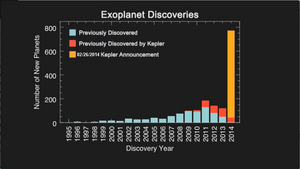
On February 13, 2014, over 530 more planet candidates were announced. Several were nearly Earth-sized and in the habitable zone. This number grew by about 400 in June 2014.
On February 26, scientists confirmed 715 new exoplanets. They used a new statistical method called "verification by multiplicity." This method quickly confirmed many candidates that were part of multi-planet systems. 95% of these new exoplanets were smaller than Neptune. Four of them, including Kepler-296f, were less than 2.5 times Earth's size and in habitable zones.
On April 17, 2014, the Kepler team announced Kepler-186f. This was the first nearly Earth-sized planet found in the habitable zone. It orbits a red dwarf star.
In May 2014, the K2 mission began observations. The first discoveries from K2 data were reported in July 2014. These were eclipsing binaries.
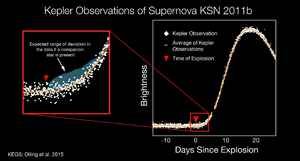
In January 2015, the number of confirmed Kepler planets passed 1,000. At least two, Kepler-438b and Kepler-442b, were likely rocky and in the habitable zone. Also, five confirmed rocky exoplanets, all smaller than Venus, were found orbiting the 11.2 billion-year-old star Kepler-444. This made it the oldest star system discovered with planets.
In May 2015, Kepler watched a newly found supernova, KSN 2011b, as it exploded. This data may help scientists understand dark energy.
On July 24, 2015, NASA announced Kepler-452b. This confirmed exoplanet is near-Earth in size and orbits in the habitable zone of a Sun-like star. The seventh Kepler planet candidate catalog was released, with 4,696 candidates.
On September 14, 2015, astronomers reported strange light changes from KIC 8462852. This star was detected by Kepler. Scientists suggested different ideas for the changes, including comets, asteroids, or even an alien civilization.
By May 10, 2016, Kepler had confirmed 1,284 new planets. About 550 of these could be rocky planets. Nine of them orbited in their stars' habitable zones:
- Kepler-560b
- Kepler-705b
- Kepler-1229b
- Kepler-1410b
- Kepler-1455b
- Kepler-1544 b
- Kepler-1593b
- Kepler-1606b
- Kepler-1638b
Kepler's Mission Status
Kepler launched in 2009 and was very successful at finding exoplanets. But problems with two of its four reaction wheels in 2013 limited its extended mission. Without three working wheels, the telescope couldn't point accurately. On October 30, 2018, NASA announced that Kepler had run out of fuel. Its mission officially ended.
Mission Extension
In April 2012, NASA scientists recommended that the Kepler mission continue through 2016. They said observations needed to go on until at least 2015 to meet all science goals. On November 14, 2012, NASA announced Kepler had finished its main mission. Its extended mission began, which lasted until it ran out of fuel in 2018.
Reaction Wheel Problems
In July 2012, one of Kepler's four reaction wheels (wheel 2) failed. On May 11, 2013, a second wheel (wheel 4) failed. This put the mission's future at risk. Kepler needed three wheels to point accurately for planet hunting. It hadn't collected science data since May because it couldn't point well enough.
Tests in July and August showed that neither failed wheel could be fixed. On August 15, 2013, NASA announced that Kepler would no longer search for planets using the transit method. This was because the wheels couldn't be repaired. Scientists then looked into using Kepler's remaining abilities for other missions.
Ideas included searching for asteroids and comets, looking for supernovas, and finding huge exoplanets using gravitational microlensing. Another idea was to change Kepler's software. This would allow it to track stars even if they drifted in its view. This could help recover the mission's goals.
Scientists continued to analyze the data already collected.
The K2 Mission: Second Light
In November 2013, a new mission plan called K2 "Second Light" was proposed. K2 would use Kepler's remaining abilities. Its camera precision would be about 300 parts per million, compared to 20 parts per million earlier. It would collect data for studying supernova explosions, star formation, and objects in our Solar System, like asteroids and comets. It would also find and study more exoplanets.
In this new plan, Kepler would search a much larger area in the plane of Earth's orbit around the Sun. Objects found by the K2 mission would be given an "EPIC" name, standing for Ecliptic Plane Input Catalog.
In early 2014, the spacecraft was successfully tested for the K2 mission. From March to May 2014, test data was collected. On May 16, 2014, NASA approved the K2 mission extension. Kepler's precision for K2 was estimated to be 50 PPM. Later measurements showed it was even better, at 44 PPM. This meant K2's precision was almost as good as Kepler's original mission.
On May 29, 2014, details of K2's observation fields were released.
Field 1 of the K2 mission looked towards the Leo-Virgo area of the sky. Field 2 looked towards Scorpius. This field included two globular clusters, Messier 4 and Messier 80.
On December 18, 2014, NASA announced that the K2 mission had found its first confirmed exoplanet, a super-Earth called HIP 116454 b. Its signal was found in test data.
On April 7, 2016, Kepler went into emergency mode, its lowest and most fuel-intensive state. Mission control declared a spacecraft emergency. By April 10, it was in a stable "point-rest" state. The cause of the emergency was unknown. Kepler returned to science mode on April 22.
In June 2016, NASA extended the K2 mission for three more years. This was beyond the expected fuel exhaustion in 2018. In August 2018, NASA woke the spacecraft from sleep mode. They adjusted its settings to deal with thruster problems. It began collecting data for its 19th observation campaign. This showed that it still had some fuel left.
Sharing Kepler's Data
The Kepler team originally promised to release data within one year. But this plan changed after launch. Data was then scheduled to be released up to three years after collection. This caused some criticism. So, the Kepler science team released some data earlier. Data through September 2010 was made public in January 2012.
Help from Others
The Kepler team regularly released lists of candidates (Kepler Objects of Interest, or KOIs) to the public. Using this information, other astronomers confirmed candidates. For example, they confirmed KOI-428b in 2010, later named Kepler-40b. In 2011, they confirmed KOI-423b, later named Kepler-39b.
Citizen Scientists Join In
Since December 2010, Kepler's data has been used for the Planet Hunters project. This project lets volunteers look for transit events in Kepler images. They help find planets that computer programs might miss. By June 2011, volunteers had found 69 possible candidates that the Kepler team hadn't seen. The team planned to give credit to amateurs who found such planets.
In January 2012, the BBC program Stargazing Live asked for volunteers to analyze data from Planethunters.org. This led two amateur astronomers to discover a new Neptune-sized exoplanet, named Threapleton Holmes B. By early 2012, 100,000 other volunteers were also helping. They analyzed over one million Kepler images. One exoplanet, PH1b (or Kepler-64b), was discovered in 2012. A second, PH2b (Kepler-86b), was found in 2013.
In April 2017, the ABC Stargazing Live launched the "Exoplanet Explorers" project. This project used recent K2 mission data. On the first day, 184 transit candidates were found. On the second day, the team found a star system, later named K2-138, with a Sun-like star and four super-Earths. In the end, volunteers helped find 90 exoplanet candidates. The citizen scientists who helped discover the new star system will be listed as co-authors on the research paper.
Confirmed Exoplanets
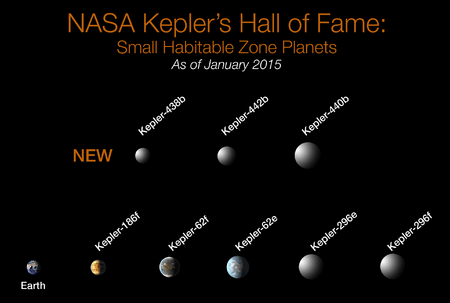
Exoplanets discovered using Kepler data, but confirmed by other researchers, include KOI-423b, KOI-428b, KOI-196b, KOI-135b, KOI-204b, Kepler-45 (formerly KOI-254b), KOI-730, and Kepler-42 (formerly KOI-961). The "KOI" part means the star is a Kepler Object of Interest.
Kepler's Star Catalog
The Kepler Input Catalog is a public database. It lists about 13.2 million stars. These stars were used for Kepler's studies. However, only some of these stars could actually be observed by the spacecraft.
Looking at Our Solar System
Kepler was given a special code, (C55). This allowed it to report its observations of small Solar System bodies to the Minor Planet Center. In 2013, a new mission idea called NEOKepler was suggested. This would use Kepler to search for near-Earth objects, especially dangerous potentially hazardous asteroids (PHAs).
Kepler's unique orbit and wide view allowed it to look for objects inside Earth's orbit. A 12-month survey could greatly help find PHAs. Kepler's first discovery in our Solar System was (506121) 2016 BP81. This was a 200-kilometer cold classical Kuiper belt object located beyond the orbit of Neptune.
Kepler's Retirement
On October 30, 2018, NASA announced that the Kepler space telescope had officially retired. It had run out of fuel. After nine years of service, it discovered over 2,600 exoplanets. Kepler will stay in its current, safe orbit, far from Earth. The spacecraft was turned off with a "goodnight" command on November 15, 2018. Kepler's retirement happened on the 388th anniversary of Johannes Kepler's death in 1630.
See also
 In Spanish: Kepler (telescopio espacial) para niños
In Spanish: Kepler (telescopio espacial) para niños


